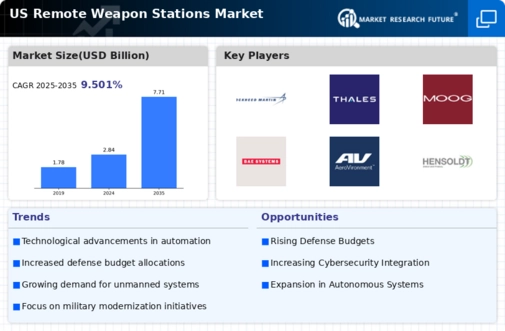The remote weapon-stations market is characterized by a dynamic competitive landscape, driven by technological advancements and increasing defense budgets. Key players such as Northrop Grumman (US), General Dynamics (US), and BAE Systems (GB) are at the forefront, each adopting distinct strategies to enhance their market positioning. Northrop Grumman (US) focuses on innovation, particularly in integrating artificial intelligence into their systems, which appears to be a critical differentiator. Meanwhile, General Dynamics (US) emphasizes regional expansion, particularly in the Asia-Pacific region, to capture emerging market opportunities. BAE Systems (GB) is actively pursuing partnerships with local defense contractors to bolster its supply chain and enhance its operational capabilities. Collectively, these strategies contribute to a competitive environment that is increasingly reliant on technological sophistication and strategic collaborations.
In terms of business tactics, companies are localizing manufacturing to reduce costs and improve responsiveness to market demands. Supply chain optimization is also a priority, as firms seek to mitigate risks associated with global disruptions. The market structure is moderately fragmented, with several key players exerting influence, yet the presence of numerous smaller firms adds complexity to the competitive dynamics. This fragmentation allows for niche players to thrive, particularly those specializing in specific technological innovations.
In October 2025, Northrop Grumman (US) announced a partnership with a leading AI firm to enhance the capabilities of its remote weapon-stations. This collaboration is expected to integrate advanced machine learning algorithms, potentially revolutionizing target acquisition and engagement processes. The strategic importance of this move lies in its potential to significantly improve operational efficiency and effectiveness in combat scenarios, thereby positioning Northrop Grumman (US) as a leader in the integration of AI within defense systems.
In September 2025, General Dynamics (US) secured a contract worth $500M to supply remote weapon-stations to a key ally in the Middle East. This contract not only underscores the company's commitment to expanding its international footprint but also highlights the growing demand for advanced defense solutions in volatile regions. The strategic significance of this contract is multifaceted; it enhances General Dynamics' revenue stream while reinforcing its reputation as a reliable defense partner.
In August 2025, BAE Systems (GB) completed the acquisition of a small technology firm specializing in sensor technologies. This acquisition is likely to enhance BAE's product offerings, particularly in the realm of situational awareness for remote weapon-stations. The strategic importance of this move is evident, as it allows BAE Systems (GB) to integrate cutting-edge sensor capabilities into its existing systems, thereby improving overall performance and operational effectiveness.
As of November 2025, current trends in the remote weapon-stations market include a pronounced shift towards digitalization and AI integration, reflecting broader technological advancements in defense. Sustainability is also becoming a focal point, with companies exploring eco-friendly materials and processes. Strategic alliances are increasingly shaping the competitive landscape, as firms recognize the value of collaboration in driving innovation. Looking ahead, competitive differentiation is likely to evolve, with a shift from price-based competition to a focus on technological innovation, reliability of supply chains, and the ability to deliver advanced solutions that meet the complex demands of modern warfare.























Leave a Comment